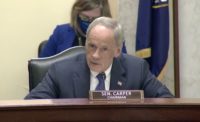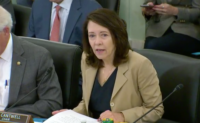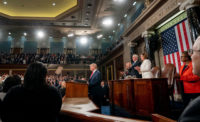The Senate Environment and Public Works Committee has unanimously approved a five-year, $287-billion highway bill, an eagerly awaited initial piece of what would be a multi-part surface transportation package.
The measure, which the committee cleared on July 30 on a 21-0 vote, would amount to a 27% increase over current authorized funding, but because the committee’s jurisdiction doesn’t cover revenue, the bill doesn't address where the additional money would come from.
The bill’s authors—committee Chairman John Barrasso (R-Wyo.) and the panel’s top Democrat, Tom Carper (Del.)—said the measure’s total dollars, from the Highway Trust Fund, would make it the largest highway bill ever and 27% more than the highway portion of the current five-year legislation, the 2015 Fixing America’s Surface Transportation, or FAST, Act.
[View summary of the bill, America's Transportation Infrastructure Act, here and text of 467-page bill as introduced here. Excludes commmittee-added amendments.]
Construction and transportation groups, for which a multi-year surface transportation bill is the leading legislative priority, praised the new bill as a solid start to what will be months of debate on the eventual package.
The deadline for lawmakers is more than a year away—Sept. 30, 2020, when the FAST ACT lapses.
Still to come are separate legislative components for transit, from Senate banking; highway safety, from Senate commerce; and—most importantly—revenue, from the Finance Committee.
There has been no action yet in the House, where the Transportation and Infrastructure Committee has responsibility for everything in the package except revenue, which is up to Ways and Means.
Positive reviews from industry
Still, Stephen Sandherr, Associated General Contractors of America’s chief executive officer, said in a statement the Barrasso-Carper proposal “is a critical first step” and said the total authorization level is “a substantial, and much needed, boost in funding to repair clogged highways and aging bridges.”
Industry officials also were pleased that the bill has a multi-year span. Linda Bauer Darr, American Council of Engineering Companies president and CEO, said in a July 29 letter to Barrasso and Carper that the bill would "ensure five years of stable federal funding and growth in core infrastructure programs."
Dave Bauer, American Road & Transportation Builders Association CEO, said in a statement that the multi-year measure also is "a welcome departure from the series of extensions and years of delay that have plagued the last few surface transportation bills."
Of the $287-billion total highway authorizations in the bill, $259 billion, or 90%, would be distributed to states by formula, basically a status quo share.
State departments of transportation strongly support formula distribution. Jim Tymon, American Association of State Highway and Transportation Officials executive director, said in a statement that funding mechanism “ensures flexibility to best meet each state’s unique highway investment needs.”
In a provision that Barrasso has long been advocating, the bill also aims to speed up highway and bridge project regulatory reviews, codifying some Trump administration policies.
Among other things, that “streamlining” section would set a goal for completing projects' environmental reviews within two years, and call for one environmental statement and record of decision per project, which all relevant reviewing federal agencies would be required to sign.
Climate-related provisions
In a move that Carper spearheaded, the ATIA has a $10-billion title dealing with climate-related activity—a first, he said, for highway bills. It includes aid for projects focused on trimming carbon emissions and for making highway projects more resilient.
That part of the bill includes a new program, funded at $4.9 billion over five years, for features that would make highways and bridges better able to withstand hurricanes, floods and wildfires. Of the $4.9 billion, $3.9 billion would be divided among states by formula; the other $1 billion would go for competitive grants from U.S. DOT, according to a bill summary from the committee.
In addition, $3 billion over five years would be directed to states by formula for projects that would reduce carbon emissions related to highways. Another $500 million over five years would be competitively awarded to states that trim per-capita emissions.
There also would be $1 billion for infrastructure to support alternative-fuel vehicles.
Another new provision in the measure is a $6-billion allocation over five years for improving deficient bridges, with the dollars competitively awarded by U.S. DOT. Of the $6 billion, $3.3 billion would come from the Highway Trust Fund.
The text of this article has been updated on 7/30/19 to reflect new information.





Post a comment to this article
Report Abusive Comment